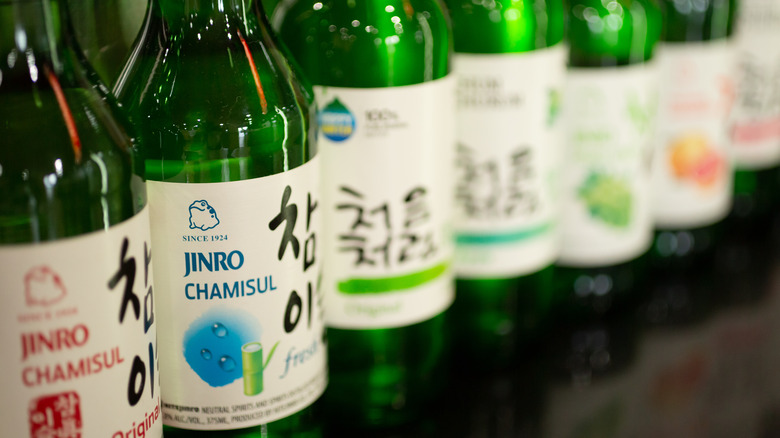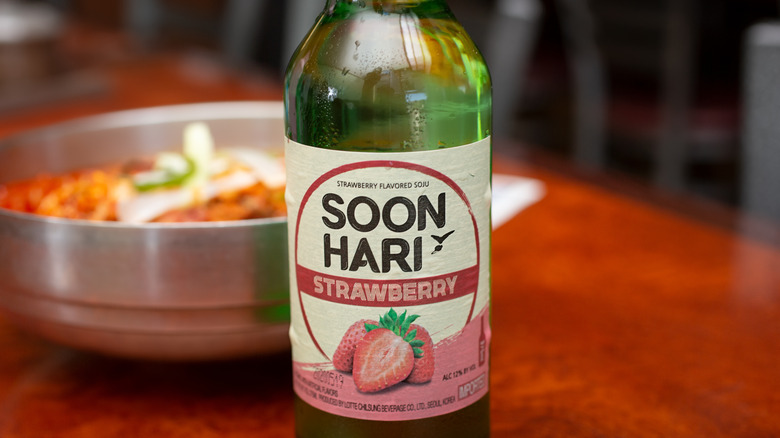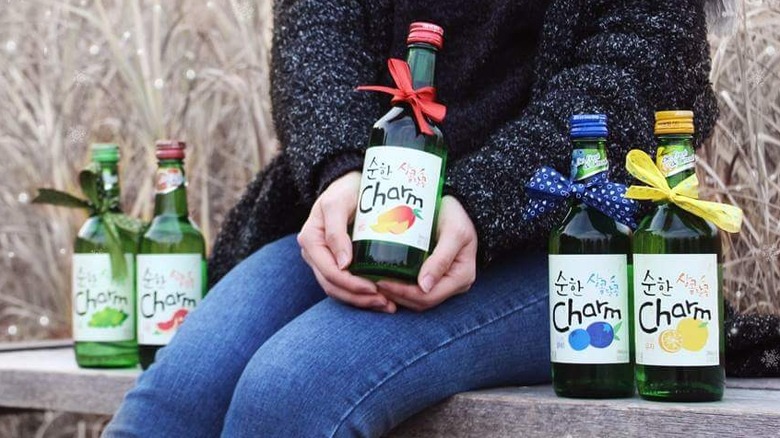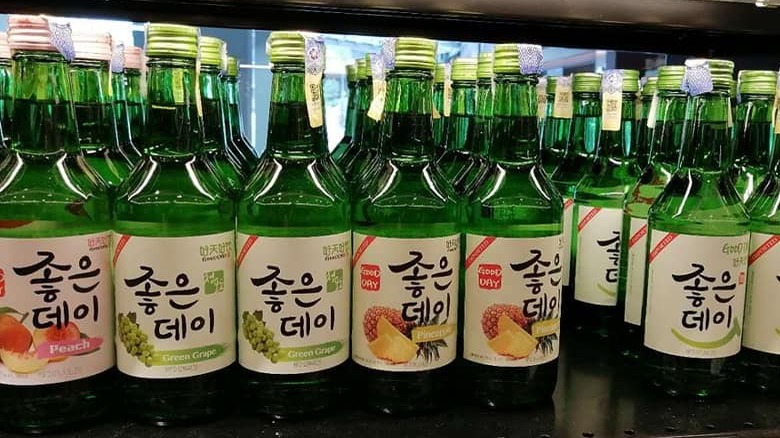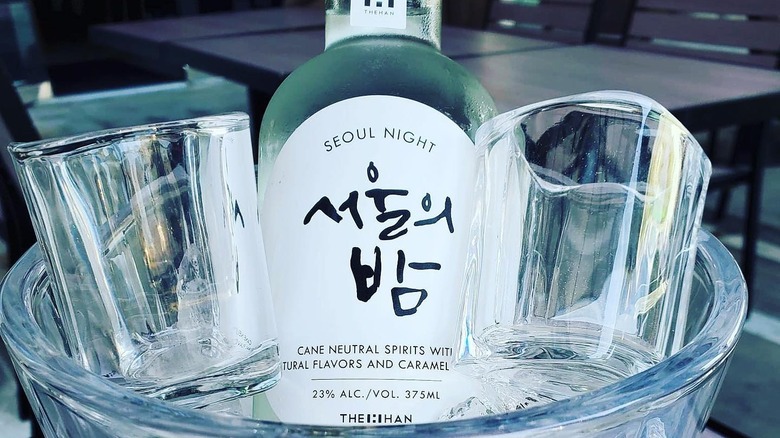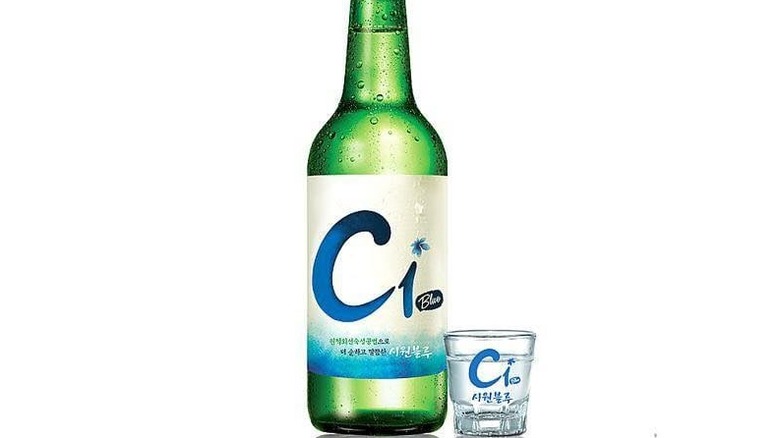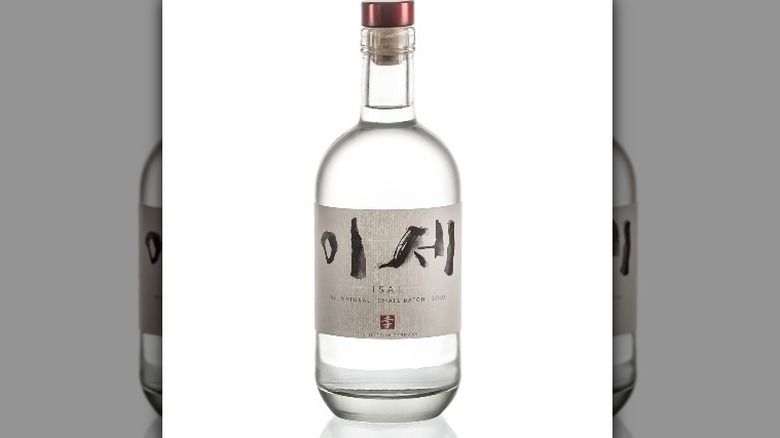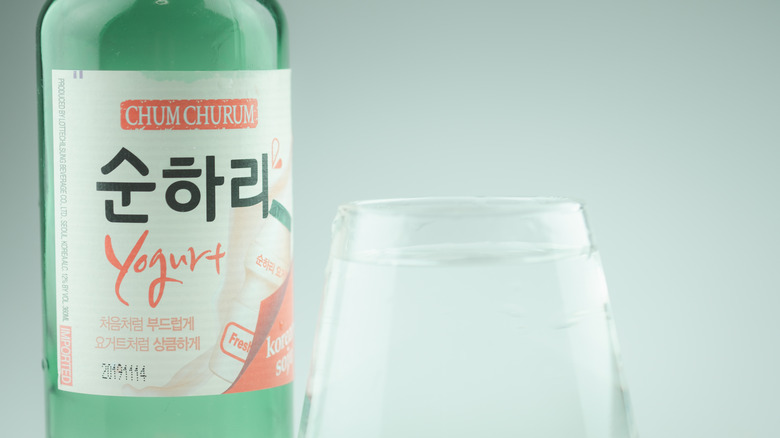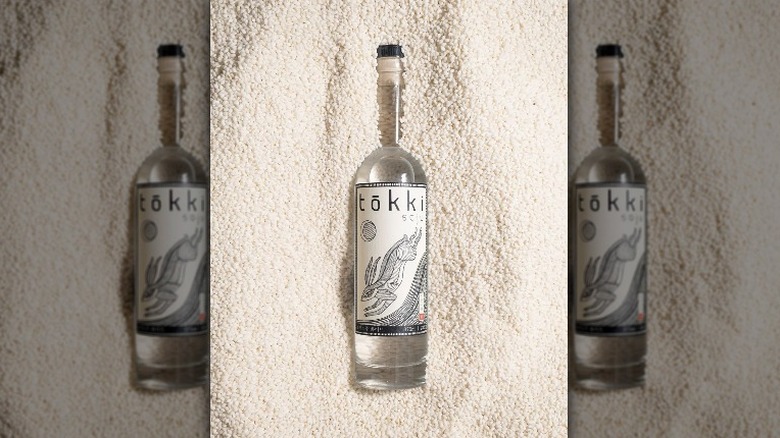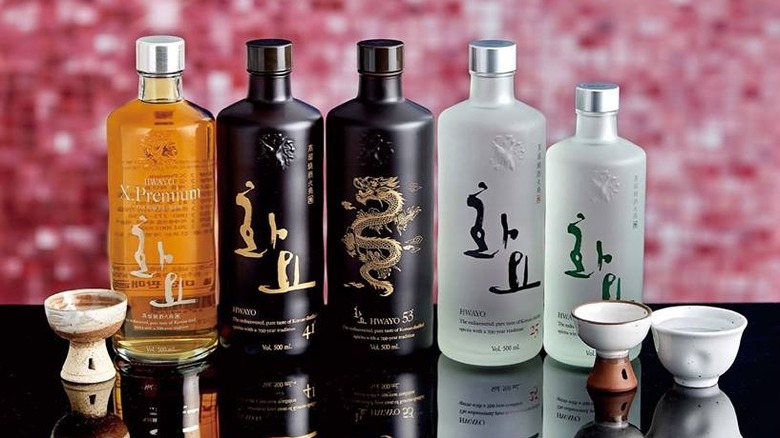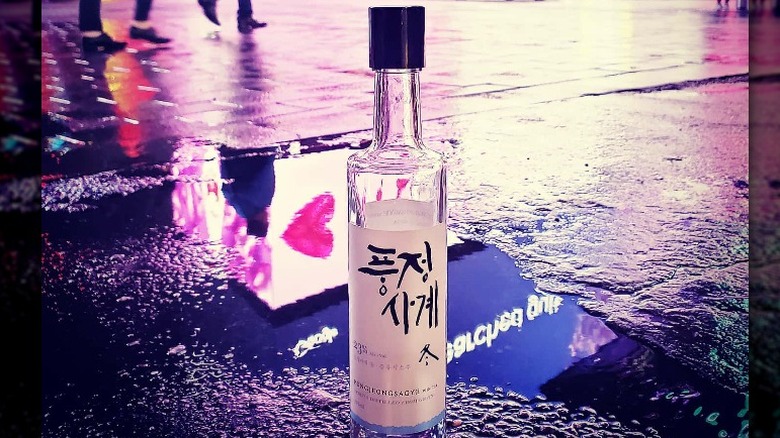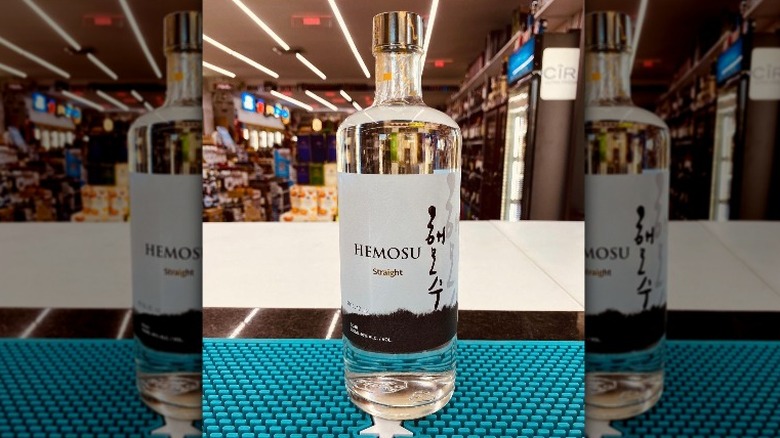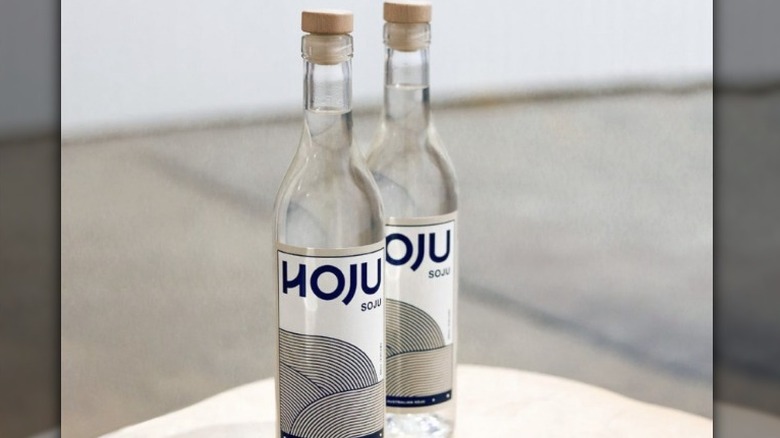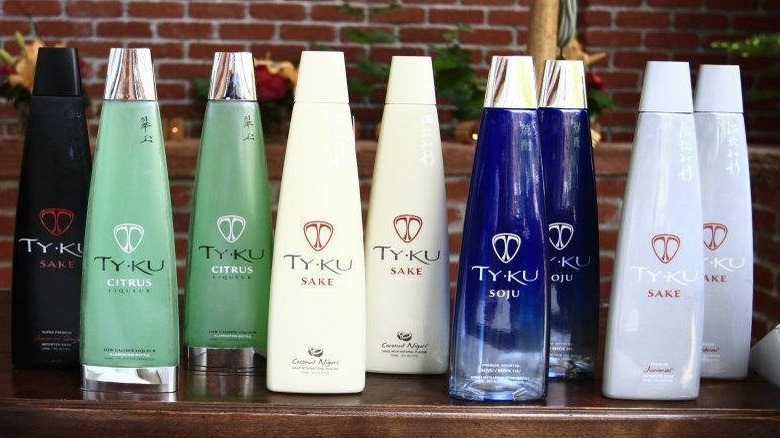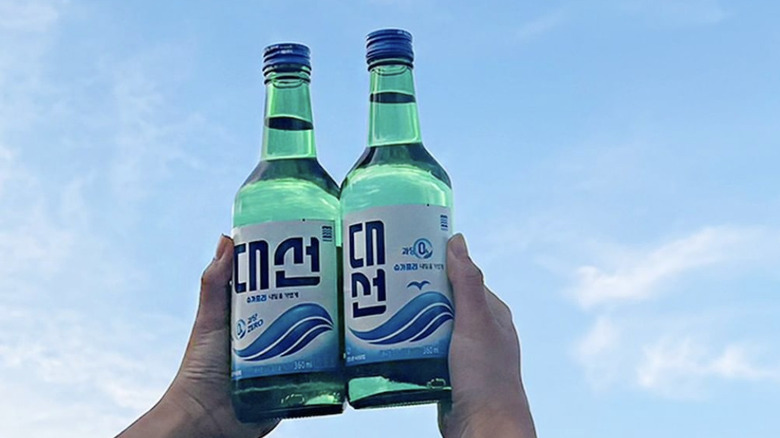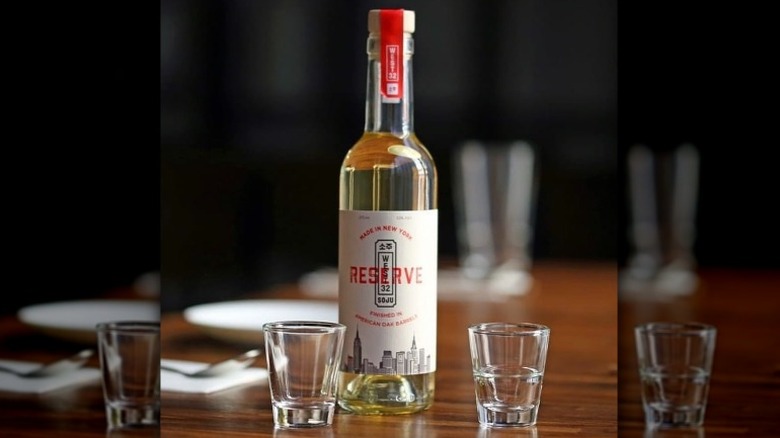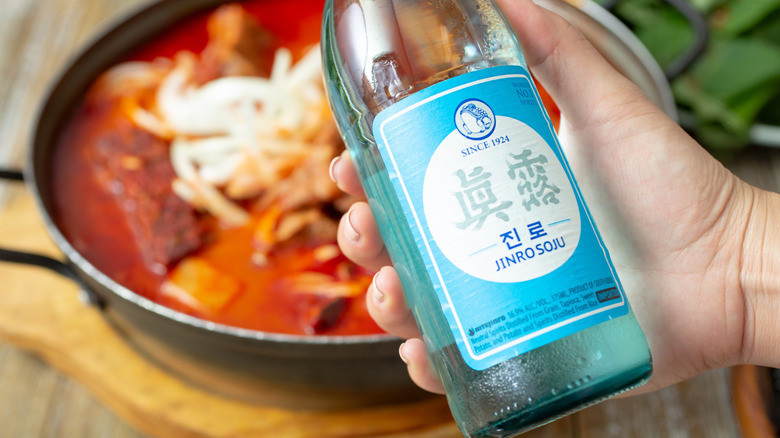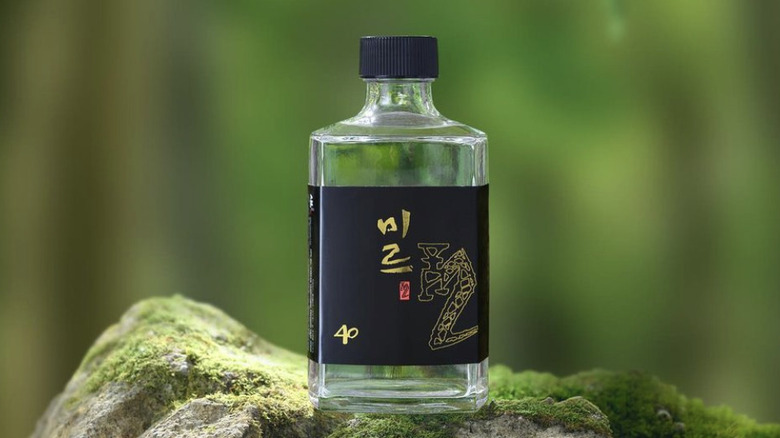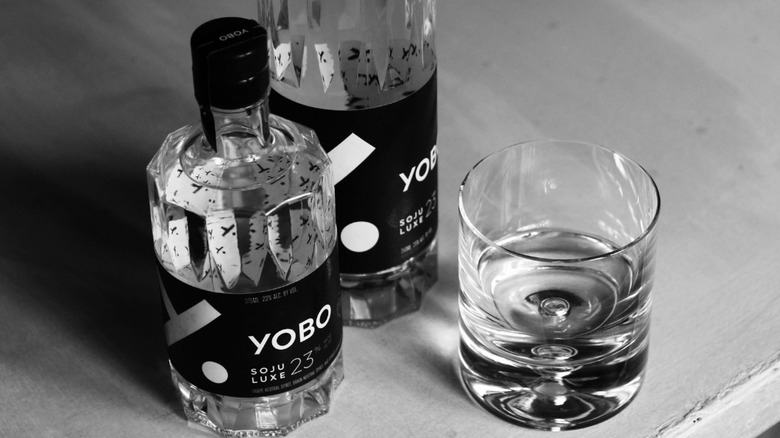18 Best Soju Brands, Ranked
Sake, the Japanese rice-based wine, enjoys an elevated global stage analogous to wine derived from grapes, but Korea's traditional beverage, soju, has begun to creep into Western grocery stores and menus of all kinds. Though an array of subtle differences demarcate the two, clear beverages, soju oftentimes is flippantly referred to as "the sake of Korea" instead of having its own moment to shine.
Though both drinks are made from rice, soju oftentimes includes other grains, botanicals, and even starches, resulting in s sweeter taste and higher alcohol content, notes Vinepair. With many popular Korean pieces of media entering the Western mainstream, like "Squid Games," BTS, and the influx of K-dramas on Netflix, it's not surprising that mainstream culture's curiosity regarding the country's food and beverage is beginning to be stoked as well. Far more dimensional than the Korean BBQ the country is known for in America, Korean cuisine contains multitudes of micro-cultures depending on region, interpretation, and venue. And to drink alongside each of these meals and occasions is a clear, clean, crisp soju also meant for every circumstance. Ranging from being meant to drink while casually out on the town, to swig while making your way through a feast, savoring while sipping gently, and shaking into an original cocktail, soju, like every other spirit, deserves the stage and consideration of the major player in the beverage world it has become in the last 10 years.
18. Soonhari
Soonhari, a brand name that translates to "smooth," cornered the young, female-identifying consumers of Korea by marketing a soju both low in calories and one whose celebrity spokesmodels are often K-Pop stars and actors. Most recently, Blackpink's Jennie Kim, simply known as Jennie, has signed on as the brand's face of the #partywithme campaign, with commercials and life-size cutouts of her likeness lining liquor aisles.
Easily found in the aisles of Asan grocery stores, Soonhari is a soju brand that enjoys the reach of mass appeal and accessibility. Another offshoot of the Lotte brand, Soonhari produces a 12% ABV soju distilled from rice, sweet potatoes, and tapioca resulting in a subtly sweet, creamy-textured, soju that drinks easily but lacks dimension. Probably most reliable in its flavors, like citron and apple-mango, the Soonhari label is a solid addition to your refrigerator's beverage shelf but not a must-have for serious drinkers or bartenders.
17. Charm Soju
With a bottle similar to its competitors, it's easy to confuse Charm Soju with the likes of more common brands such as Soonhari and Chum Churum but the soju, made from a base of rice, sweet potatoes, and barley has a flavor profile all its own.
Both reminiscent of nougat and acorn, Charm soju carries a thicker, creamier mouthfeel that can stand up to some of the spicy dishes Korean cuisine is known for, as well as a smoothness handy for cocktails most commonly made with vodka like cosmos, and flavored martinis. A far cry from the luxury soju's we've seen crop up in the last ten years, Charm still holds a place in a grocery store aisle all its own for its uniqueness and candied, rice-milk texture. But like a lot of entry-level brands, it leans too heavily on its flavor infusions as opposed to honing in on its base flavor, leaving us with a bottle we like for casual parties but not one we look to for special occasions.
16. Good Day Soju
Another brand ubiquitous in the markets and restaurants of Korean businesses throughout the world is the cheerily-named Good Day Soju, the chief commodity of Korea's Muhak distillery which has been operating since 1929.
Like most widely distributed soju brands, Good Day offers flavored versions of its flagship product (our favorites being pineapple and melon) but the Good Day claim to fame lies in the waters of Masan, an area known for its cleanliness. Made entirely of rice, Good Day's soju also undergoes ten filtrations and a 72-hour long distillation process which includes the liquid's infusion with oxygen, resulting in a cleaner, clearer end-product.
Reminiscent of mid-level vodka brands like Ketel One, Good Day Soju tastes light on its toes without a sharp, alcoholic bite, making it a bottle we'd gladly keep around for Korean drinking games (like these listed on 10 Magazine), and causal suppers, but if we're cooking an elaborate Korean BBQ dinner or incorporating soju in a cocktail, we'll look toward higher-end bottles.
15. Seoul Night Soju by The Han
Somewhere between a flavored soju and a sophisticated rendition of the beverage, Seoul Night is a non-serious, plum soju perfect for a date night, or to sip on its own, but the intense plum flavor resonates a little too strongly to pair with a meal.
The floral, flirty taste is dry on the palette and works for a soju novice's first steps into higher-end bottles without breaking the bank on polarizing flavors. Made from golden maesil plums and double distilled cold, notes Flask & Field, Seoul Night is the newcomer with a gentle lift of flavor and reminds us of the White Claw and the boozy seltzer movement. It's light, inoffensive, low in calories, and it's easy to swig an entire bottle without realizing it. Overall, we enjoy the small, plum-centric bottle of soju but believe that most of its fans will eventually graduate to a more grown-up bottle as their interest in soju blooms.
14. C1 Blue Soju
Short for "Clear One," and hailing from Busan, Korea's second-largest city, C1 Soju is a relative newcomer to American markets (first arriving in 2015) and can be found mostly in Korean markets along the West Coast stateside.
Distilled from rice with natural bedrock waters from Mount Samgak, reports Wine-Searcher, Busan's favorite soju also claims to deliver softer hangovers due to the presence of asparagine in its bottling processes. Found naturally in asparagus, the amino acid added to C1 Soju is thought to alleviate headaches brought on by over-drinking and shield liver cells against toxins. In any case, the soju tastes polished for its price point, leaving the tongue crisp and ready to indulge in some of Korea's most spicy and fatty foods, like Korean fried chicken, but might not be the bottle of soju we reflexively reach for based on taste alone. The flimsy promise of preventing headaches is C1's main draw, but we're not trying to drink enough of the clear liquid to find out if it's true.
13. Isae Soju
Another relative newcomer to the soju scene is Germany's Isae Soju, the country's first and only soju manufacturer. Made from winter wheat and organic rice, Isae rejects the notion of flavor additives and other unnecessary agents in its soju. Meaning "second generation," Isae Soju represents one family's immigration to Germany in the 1960s and traces its legacy to today, where the founder produces the only traditional Korean soju crafted in the country.
Akin to the global acknowledgment of the natural wine movement, Isae shies away from artificial sweeteners or industrial additives intended to lure drinker's in with an agreeable flavor, but later leave them with a headache. We're pulling for Isae's expansion to the U.S. market, but due to Isae's small batch nature, it's difficult to track down Isae Soju stateside, but the newcomer shows promise and could be one of our go-to bottles in the coming years.
12. Chum Churum Soju
Lotte's Chum Churum should look familiar to anyone familiar with Korean markets (like H Mart) since the brand sits just under Jinro as the globe's most-sold bottle of soju.
Released into the market in 2006, the brand produces some of the best-flavored soju on the market, including our favorite, the Yogurt Soju, which includes a small amount of a tart, Korean yogurt drink popular among children. But the brand's claim to fame must be an amendment to the distillation process; distilled from alkaline water, Chum Churum claims that the mineral-heavy water leads to a smoother, less acidic bite.
The original and best-selling bottle is distilled from rice, potato, and sweet potatoes and carries a 16.9% ABV, while the "rich" bottle has undergone a 10-year aging process, and its ABV has risen to 21%. Overall, the Chum Churum earmark seems to be a slightly sweeter, candied flavor we associate with the first years of our drinking biography when we were most interested in beverages that wouldn't offend our relatively young palate.
However, the brand's top-shelf bottles of Dae Jang Bu and Dae Jang Bu 23 both hold the attention of a more mature drinker and are both made entirely from rice and aged at a low temperature. The only difference being the bottles of Dae Jang Bu 23 also experience a short time in oak barrels, making both premium bottles more akin to high-end vodkas in their overall taste and finish.
11. Tokki Soju
Meaning "bunny" in Korean, Tokki Soju is one of America's first ventures into the soju market. After learning to make soju in 2011, native New Yorker Brandon Cook returned stateside to hone his craft and released the first bottle of Tokki Soju in 2016. Hill's background in both rum and whiskey distilling informs his palette when creating this elegant soju label found in many upscale Korean restaurants and bars in New York and Brooklyn, where Tokki operations call home.
Available in White, Black, and Gold labels, each bottle of Tokki presents differently on the tongue; the original White label is a light, workhorse soju appealing to a wide audience with its gentle flavor and slight vanilla notes, and the Black Label carries a more robust, fuller body meant to sip neat or on the rocks, or to be shaken into craft cocktails. But Tokki's Gold Label, intended to appeal to serious whiskey drinkers, is the crown jewel; barrel-aged, golden brown in color, and 46% ABV, the Gold Label liquid owns dark cherry and chocolate notes but finishes clean with airy eucalyptus notes.
10. Hwayo Soju
As we dip our toes in the world of artisanal sojus, the Hwayo brand emerges as one of the spirit's highest-regarded labels. Tacitly intended to be served in Korean earthenware known as onggi, the history of Hwayo sojus has its roots in the brand's desire to elevate and popularize Korean-style cooking and hosting to a wider audience.
Unlike American bourbon, Hwayo keeps a master distiller or an employee whose job duties entail overseeing the consistency of the spirit on staff. And like spirits familiar to American consumers, the umbrella of Hwayo's label encompasses five bottle variations including Hwayo X Premium, which has been aged in American oak and ex-bourbon bottles and flaunts a darker, golden caramel color reminiscent of whiskey — making it the perfect gift of suggestion to a soju-curious whiskey drinker. Our favorite, however, is the brand's Hwayo 41, a high-proofed (41% ABV) soju intended for cocktails that can easily stand in for gin and vodka.
9. Pungjeong Sagye Winter Soju
Fully embracing soju's traditional methods, and without the inclusion of flavors or gimmicks, Pungjeon Sagye Winter Soju is an aromatic alternative to the oftentimes intentionally meek beverage. Against the grain when compared to most sojus, Pungjeon Sagye Winter Soju strives for a personality all its own and isn't over-reliant on multiple filtrations or the inclusions of sugars or flavors to create a soju that sings. Unobtrusive and giving toward almost meal, Pungjeon Sagye Winter Soju compliments the flavors it's served alongside-whether in a cocktail or paired with food.
Using a nuruk (a Korean fermentation starter) that includes mung bean (prevalent in Korean cuisine), called Hyang on Gok, Pungjeong Sagye Winter Soju strives for complex, dimensional flavors as well as soju's signature clean tasting notes. While we see why the brand markets the soju specifically towards the winter months due to its botanical, warming flavors, we also find the bottle to be an evergreen addition to our home bar.
8. Hemosu Soju
Perhaps the only soju that shares a botanical blend more like tasting notes found in gin than vodka, Hemosu Soju produces several luxury bottles besides its flagship "Straight Soju" bottle, including a ginseng bottle, a barley bottle, and our favorite Hemosu's Pine Forest bottle. Like the juniper-based spirit, the Hemosu distillery strives to translate the beverage's terrier rather than hide the flavor of the spirit, and each of the variations creates a unique bottle with a swagger all its own.
Passed down for over 16 generations, the Hemosu family recipe blends a combination of pines and rice to create its signature herbal flavor. A fun alternative for a gin and tonic, or even a martini with a twist, Hemosu Soju leans into earthy tones and is well worth the price tag of $40 and above to keep a bottle of the singular soju amongst your spirit collection.
7. Hoju Soju
Americans aren't the only Westerners embracing soju's charms; Australia now produces its own bottle of soju, Hoju (meaning "Aussie") soju using proprietary ingredients found in the brand's native Australia. A far cry from Korean-produced sojus, Hoju mounts the neutral spirit from an entirely different perspective and uses a widespread, but proprietary, a combination of Australian crops to create this hybrid bottle. Caught between Australian terrain, Korean culture, and contemporary marketing, Hoju emerges as a hip, thoughtful bottle of soju, if not a little on the nose.
The brand only makes the one, unflavored product meant to be enjoyed on the rocks and in cocktails, and can cost upward of $50 a bottle, which is steep for a product known for its affordability. However, its uniqueness in the market makes it a curiosity worth sipping if you encounter it in the wild. We look forward to Hoju's growth internationally and remain curious to uncover the brand's base-spirit recipe.
6. TY KU
With a bottle fit for the club, TY KU Soju's overall look and vibe feel slightly dated and not unlike a bottle found in the background of a "Sex in the City" episode. Sleek, svelte, and matte blue, TY KU soju fits in the market primarily for night-out purposes and it is best chilled, mixed, and shot like vodka shots.
Better known for its sakes, the Naru, Japan-based spirit company branched out into the soju market n 2011 after first appearing on the scene in 2004.
Nearly tasteless on its own, TY KU Soju enhances the sugars and flavors of fruits and makes a low-calorie, low-ABV substitute for vodka-based cocktails like a lemon drop. While we still prefer Korean-made sojus for our home fridges, we do keep our eyes peeled for the TY KU blue bottle while at Japanese cocktail bars since it makes an excellent base spirit for creative cocktails.
5. Daesen Soju
Once a soju solely found in Busan Korea, its popularity persisted until the refreshing bottle of soju can now be found in the United States. Like most sojus, Daesun claims its clear-beverage is both fresh and smooth, but what Daesun alone seems to add to its soju is a sweetener called thaumatin, notes Drizzly.
Derived from katemfe fruits, the low-calorie, natural sweetener acts to counterbalance any bitter notes the soju's base grain might present and clears away a sweet, vivid path for Daesun's soju to fall on the tongue. Not for sipping on its own or to be enjoyed with a meal, Daesun is intended as a lux alternative to drinking in groups and in mixed drinks. The brand also includes a "far infrared rays" aging process in its distillation methods Daesun claims to enhance the chemical connections between water and alcohol particles, again leaving the final product with a crisper taste.
4. West 32 Soju
Hailing from NYC's West 32nd Street, West 32 Soju is another American-made soju that takes notes from its Korean predecessors. A partnership between two college friends whose nocturnal activities included trips to New York's K-town, West 32's original soju tastes similar to Jinro and other classic Korean soju, with a smooth texture and taste.
Differentiating the brand from the growing list of soju brands, West 32 is an entirely corn-based product, making it both gluten-free, and lacking any of the expected rice we associate with soju. A bottle we reach for because of it's uniqueness to both the market and our bar cart, West 32 is a far cry from the one essential bottle you need to round out your bottle shelf, but rather is a one-of-a-kind addition to a healthy spirit collection. While we like the near-invisibility of West 32's original bottle, we prefer its Reserve bottle that experiences an aging process in white American oak barrels and can be used in place of whiskey in cocktails like an Old Fashioned.
3. Jinro Soju
Somewhat of an unofficial king of the soju market, Korea's Jinro (established in 1924) has remained the best-selling spirit brand worldwide, according to Vinepair, since 2002, and the Jinro name alone resonates and is synonymous with the rice spirit. The soju giant produces a handful of flavored soju products, including grapefruit, grape, strawberry, and plum, but it's the line of pure sojus that share space in our wine rack.
Distilled entirely from rice grain, Jinro's Chamisul or "dew" remains the brand's flagship bottle, followed by Chamisul Fresh, which includes bamboo in its distillate process for a cleaner mouthfeel. Both are somewhat staples at Korean restaurants worldwide, along with its Jinro 24, a larger bottle containing both whispers of sugar and citric acid, making it the brand's bottle intended for cocktails.
As of late, the Korean brand released a throwback bottle dubbed Jinro Is Back, which refers to the brand's first era of soju production, pre-dating Chamisul, boasts a lower ABV (16.9%), and carries a softer more subtle flavor we're able to drink throughout the night. Still, the brand's premium bottle, Jinro's Ilpoom (clocking in at 24% ABV) undergoes an extra distillation process where impurities are frozen and filtered away, leaving drinkers with a smoother, crisper, whiskey-like product we consider Jinro's very best.
2. Sulseam Mir Soju
A favorite amongst Korea's upper crust, Sulseam Mir Soju hails from Korea's Gyeonggi province and is among the country's highest-regarded sojus by aficionados. Made only from rice, a starter puck (known as nuruk), and water, Mir Soju reflects soju's simple beginnings but builds on the beverage's legacy by fine-tuning the distillation technique and honing in on an exact base-spirit recipe.
At just slightly higher ABV (22%) than most conventional sojus (at around 17%), Mir is a great bottle to start elevating your soju collection beyond the bottles you're bound to find at your local Korean grocery store. Worth tracking down a bottle at a high-end or specialty liquor store, Sulseam pleases everyone from the casual soju drinker to the guest who veers toward the top-shelf option. A more polished and velvety soju, the Sulseam team produces one of the world's most traditional sojus that still boasts a slight scent of the rice grains it derives from.
1. Yobo Soju
Los Angeles-born Carolyn Kim unveiled Yobo Soju to the world in 2015 with the vision of re-centering the perceived conception of both soju and Korean culture. A Korean American herself, Kim struck out to rebuff "traditional" methods of soju making and chose to produce soju entirely from local grapes surrounding Northern California as opposed to rice and other grains more commonly found in the clear spirit.
The result, as reflected in Yobo's elegant bottle, is a bright, light, uplifting spirit, free of any sour, clingy aftertastes, and makes essential pairing not just for Korean food but also light meals of crudos, salads, and any other bites as finely honed as Ms. Kim's exemplary sojus. Meaning something akin to "darling" or "sweetheart," Yobo soju might be the only essential American soju for an adult bar cart we've tasted; disarmingly cool, effortlessly chic, and undeniably sippable, Yobo Soju represents the valedictorian of soju's newest class.
